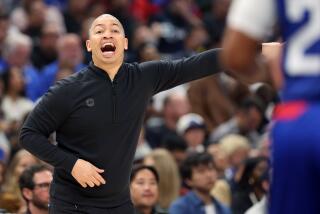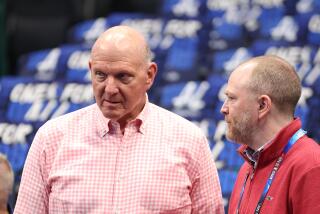Ready and Able
- Share via
If the NBA gave out awards for bad timing, Loy Vaught would have a house full of trophies by now.
He was drafted by the wrong team in the right city. He played his best basketball in the wrong seasons. He had back surgery at the wrong age, and now he’s physically sound and an unrestricted free agent with nowhere to play.
“I’ve put in so many years in the league and a lot of those were tough years,” said Vaught, a 6-foot-9 power forward caught in limbo during the NBA lockout. “Now, it’s my time, and things are still up in the air.”
Vaught’s timing problems began when he was chosen by the Clippers in the first round of the 1990 draft.
The next seven seasons, his blue-collar approach gained him the reputation as “Mr. Clipper” despite playing in relative anonymity for one of the worst franchises in NBA history. Across town, another 1990 first-round selection, Elden Campbell, enjoyed the high visibility of playing for the Lakers, although he’s known as one of the league’s most inconsistent players.
“Despite all of the problems [the Clippers] have had since he’s been there and all of the treatment he would get from fans because he played for the Clippers, Loy never talked bad about the team or his situation,” said Yvette Riley, Vaught’s fiancee. “He’s always been positive with a belief that things will get better.”
Vaught figured to be rewarded for his commitment to the Clippers once he became an unrestricted free agent. But again, the timing was wrong.
Last season, Vaught entered the final year of a four-year, $12-million contract extension he had signed in 1993. He lasted only 10 games. A lingering back problem that he had kept under control since his rookie season with painkillers and anti-inflammatory drugs became unbearable, leading to surgery last December.
Vaught had become a Clipper fixture. He had led the team in scoring and rebounding the previous three seasons, becoming the first player in franchise history to do so since Bob McAdoo in 1974-76. He had been with the team longer than any player since the franchise moved to Los Angeles and was the team’s all-time leading rebounder.
The late Times columnist Jim Murray wrote of Vaught: “He’s as dependable as sunrise, as conscientious as a monk and as undiscourageable as an insurance salesman.”
But things changed dramatically for Vaught after his surgery. Because he wasn’t around the team while he recovered, his accomplishments seemed like a distant memory by the time the Clippers limped home to a 17-65 record.
When the Clippers selected big men Michael Olowokandi and Brian Skinner in last spring’s draft to join a frontcourt already crowded with promising young players Maurice Taylor and Lorenzen Wright, Vaught’s status appeared to be in question.
After playing in pain for most of his NBA career and having a disk in his back worn away to almost nothing, Vaught found himself finally a free agent but considered damaged goods.
Vaught, however, says he thinks he’s better than ever. He began his recovery under the watchful eye of his mother, Ozzie Jager, who left Grand Rapids, Mich., to live with Vaught for several weeks in his Marina del Rey home. Vaught says that he’s sound for the first time since he played on Michigan’s 1989 national championship team, thanks to a rigorous workout schedule that includes multiple stretching exercises and steady weight training.
“Even back in college, I always had a stiff back, but I got used to dealing with it. You know how you can try and be proud and play with pain,” said Vaught, who averaged 15 points and 11 rebounds as a Michigan senior before being the 13th pick in 1990.
“Once I [joined the Clippers], I just did more things that enabled me to play. I didn’t [have surgery] earlier because I was playing well. But last year, my condition had deteriorated to the point that I needed surgery.”
Because of the lockout, the Clippers are not allowed to make any statements regarding their interest in Vaught, but it doesn’t seem likely that they’ll want him back because of the stockpile of players at his position.
So where does that leave Vaught?
“It’s really tough to tell because you never know [once the lockout ends] what the [free-agent signing period] will be like, but I think Loy will work out just fine,” said Diron Ohanian, Vaught’s attorney. “What works to his advantage is his reputation for being a hard worker. People around the league know what type of player he is and what he’ll bring to a team.”
Word around the league has several teams interested in Vaught, ranging from the New York Knicks and Detroit Pistons to the Lakers.
“If you watch him work out, you see a guy who is not grimacing in pain anymore,” Ohanian said. “You can see the explosion in his game that had been missing the last couple of years. You can see his confidence grow every day. He’s excited to get back playing.”
Vaught, who will turn 32 in February, says he would like to play for a team that already has a dominant center and a steady point guard. With his tenacity to rebound and willingness to defend the low post, Vaught is the ultimate role player.
“Loy has great character and works extremely hard, setting an excellent example for the younger players on the team, and that can’t be underestimated,” former Clipper coach Bill Fitch said. “He’s just got overwhelming class.”
Knowing which team’s uniform he’ll next be wearing is not as important as playing again for Vaught. After being in the wrong place at the wrong time for most of his NBA career, he reckons that his timing has to get better once the lockout ends.
“When I got hurt, there was a lot of uncertainty over what was going to happen [regarding the lockout],” Vaught said. “At first, I thought, ‘This is good because it will give me a little more time to get ready.’ But now, I just want it over. Everything happened so quickly for it to start and now it has gone longer than any of us imagined.
“I can only hope that we get playing soon.”
More to Read
Go beyond the scoreboard
Get the latest on L.A.'s teams in the daily Sports Report newsletter.
You may occasionally receive promotional content from the Los Angeles Times.






